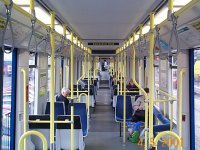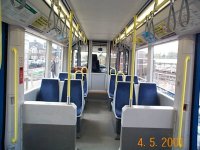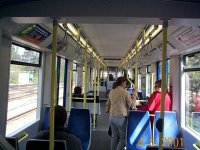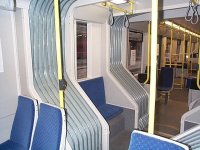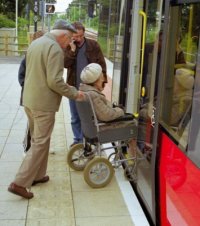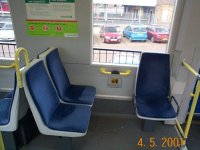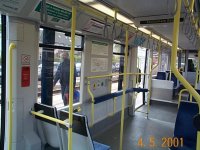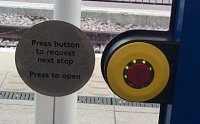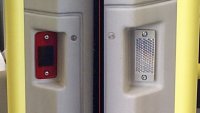|
||||||||||||
|
Home | ||||||||||||
  
|
||||||||
|
|
||||||||
|
On the Trams |
||||||||
Each tram has 70 seats - 33 in the A and B cars and 2 on each side of the centre C Car. It is estimated that the tram can hold 138 standing passengers. Inside the tram, there are plenty of handrails and you can walk the entire length of the tram. The outer ends, beyond the outer doorways are high floor with the remainder - 76% Low Floor. Most surfaces are white with blue seat covers (with yellow and black moquette. All handrails are yellow with grey hand straps on the longitudinal rails. Some youths have tend to swing from the handrails and drivers have made announcements such as "This is a tram, Not a gymnasium" over the PA. Drivers are able to use mirrors to see back into the trams. The seats at the front are best for enthusiasts with the left hand window seat and right hand isle seat giving the best views. During the day, most drivers keep the blinds rolled up to give a clear view of the line ahead. Photos can easily be taken. Even when down, you can see out. The low floor area in each car incorporates a disabled area which can hold pushchairs and wheelchairs in addition to space available in the door vestibules. This area also features a convenient perch for standing passengers. Each half has one dedicated priority seat which is longitudinal and has addition hand rails. The 350mm high doorways line up precisely with the platforms for level access for wheelchairs, pushchairs and those with walking difficulties. Trams accelerate and brake very smoothly and this means it is quite safe to have a pushchair or wheelchair unsecured. The driver is able to make announcements over the trams PA system both internally and externally and communicate with the passengers through an intercom by each door, as well as in each disabled bay. Each car also has a double sided 'Next Stop' Indicator at the midpoint that displays the next stop. This is operated manually by the driver using the IBIS computer that also works the recorded 'Next Stop' announcements. All stops on the system are technically request stops and may be skipped if the tram is late and no one requires the stop. In practice, trams rarely skip stops, especially during the daytime. Stop request push buttons are provided and signs located at each end of the A and B cars illuminate within the saloon when the tram has been requested to stop. Tram doors can either be released by the driver so that the passengers can open them by means of a push button on the door and they will then close automatically as long as no one is standing in the doorway breaking the infrared beam, or the driver can open all the doors and they would remain open until they are closed again by the driver. In both cases they have a warning alarm when the doors are about to close. Should a stop request button be pushed by a passenger and the doors are released by the driver, the door nearest the activated push button will open automatically as if you had pushed the button on the door and will then close automatically. Breaking the IR beam will stop the doors from closing. Each door is equipped with an Emergency Door Release handle. Pulling this releases the doors and automatically applies the hazard brakes. Unfortunately, youths often pull these and this can cause disruption. After they have been pulled, the driver has to reset the handle with a key. In case of a door problem, any door can be isolated by means of a switch under a panel above the door. Large windows mean that you can see everything including the other traffic stuck in queues! All glass has protective anti-scratch film which is replaced every 2-3 weeks. Even if scratching is visible, it is likely that it is only on the film. Another benefit of the film is the ability to hold the glass together in case of stones or other missiles being thrown. If the glass does break, it will not shatter and cause flying glass injuries. Windows in the centre low floor section of the tram have hopper style windows for additional ventilation. Unfortunately, this does not apply to the high floor section at each end and this can result in very hot trams in the summer. Air Conditioning has been ruled out for the passenger saloons due to the frequent opening of the doors but installation in the drivers cab is a possibility. Improvements to the Forced Air ventilation system are being considered. Above the windows are standard sized advert panels as used on buses and trains. Adverts are managed for Tramlink by TDI Media, formerly LT Advertising. All enquiries for advertising should be directed to them. A wide variety of companies and Organisations advertise. Larger companies often use standard adverts leading to adverts with a distinctly 'London Underground' feel! 'Poems on the Tube' feature for example. Many other adverts are by more local Organisations such as Shopping centres nearby. Some are tram specific and some even offer discounts to tram passengers. Trams are thoroughly cleaned each night at Therapia Lane by ISS cleaners. Mobile cleaners also roam the trams in the central area (Sandilands - Wandle Park), picking up litter and cleaning up spills. Each tram should get litter picked like this every 3 hours at peak times. Trams which are not fit for service with serious spills, graffiti or less pleasant substances are usually substituted in Croydon with a spare at the depot. Providing there is a spare available, a relief driver will take a new tram out and trams will be swapped. This usually occurs at Beddington Lane or East Croydon. |
||||||||
|
|
||||||||
| Designed by Trapdoor Internet Services | ||||||||
|
|
